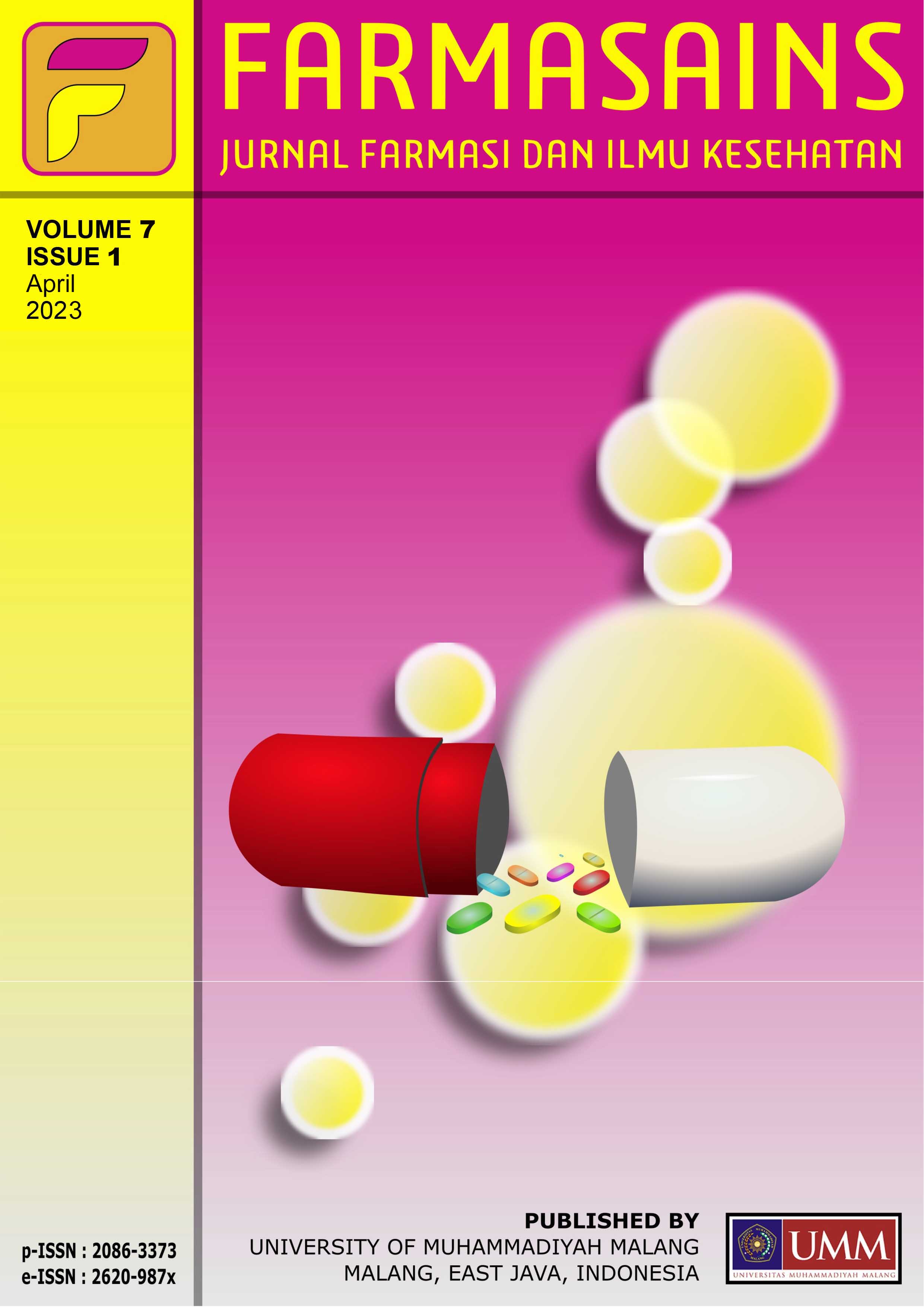The Formulation and Evaluation of Facial Wash containing Snow Mushroom (Tremella fuciformis) Extract
DOI:
https://doi.org/10.22219/farmasains.v7i1.20063Keywords:
Facial wash Snow mushroom Tremella fuciformis UAE Ethanol Hedonic testAbstract
The aims of this study were to determine and evaluate the results of the physicochemical characteristic of snow mushroom (Tremella fuciformis) facial wash, and to determine the acceptability of the snow mushroom (Tremella fuciformis) extract facial wash which has the best physicochemical characteristics. In this study, the extraction of snow mushroom (Tremella fuciformis) used UAE (Ultrasound-Assisted Extraction) and ethanol as solvent with various concentrations, 96% (F1), 75% (F2), and 50% (F3). Furthermore, the extract will be formulated into facial wash and evaluated for physicochemical characteristics. The parameters of physicochemical characteristics include organoleptic, pH, density, viscosity, spreadability, and foamability. The difference in the concentration of ethanol as menstruum of snow fungus (Tremella fuciformis) extraction did not significantly affect the organoleptic composition of facial wash, but it did affect the physicochemical characteristics of facial wash, where higher ethanol concentrations resulted in lower pH, higher density and viscosity, smaller spreadability, and foamability that meets specifications. The results of the evaluation of physicochemical characteristics showed that F1 had the best specifications and continued hedonic testing to determine the acceptability of snow mushroom (Tremella fuciformis) extract facial wash. The results of the hedonic test on F1 showed good acceptance regarding the parameters of appearance, foam, and effects after using facial wash; as well as sufficient acceptability related to aroma and viscosity parameters.
Downloads
References
An, G. et al. (2019) ‘Comparison of the physiological activities of Korean and Chinese Auricularia auricula and Tremella fuciformis extracts prepared with various solvents’, Journal of Mushrooms, 17(2), pp. 78–84. doi: http://dx.doi.org/10.14480/JM.2019.17.2.78.
Antignac, E. et al. (2011) ‘Safety of botanical ingredients in personal care products / cosmetics’, Food and Chemical Toxicology, 49(2), pp. 324–341. doi: 10.1016/j.fct.2010.11.022.
Bin, C. (2010) ‘Optimization of extraction of Tremella fuciformis polysaccharides and its antioxidant and antitumour activities in vitro’, Carbohydrate Polymers, 81(2), pp. 420–424. doi: 10.1016/j.carbpol.2010.02.039.
Chang, S.-T. and Miles, P. G. (2004) MUSHROOMS Cultivation, Nutritional Value, Medicinal Effect, and Environmental Impact. 2nd edn. United States of America: CRC Press LLC.
Draelos, Z. D. (2017) ‘The science behind skin care : Cleansers’. doi: 10.1111/jocd.12469.
Eugresya, G., Avanti, C. and Uly, A. (2017) ‘Pengembangan Formula dan Uji Stabilitas Fisik-pH Sediaan Gel Facial Wash yang Mengandung Ekstrak Etanol Kulit Kayu Kesambi’, 1(4). doi: 10.24123/mpi.v1i4.769.
Lin, C. and Tsai, S. (2019) ‘Differences in the Moisture Capacity and Thermal Stability of Tremella fuciformis Polysaccharides Obtained by Various Drying Processes’, Molecules, 24(2856).
Ma, X. et al. (2021) ‘A review on the production, structure, bioactivities and applications of Tremella polysaccharides’, International Journal of Immunopathology and Pharmacology, 35. doi: 10.1177/20587384211000541.
Nn, A. (2015) ‘A Review on the Extraction Methods Use in Medicinal Plants , Principle , Strength and Limitation’, Medicinal & Aromatic Plants, 4(3), pp. 3–8. doi: 10.4172/2167-0412.1000196.
SpecialChem (2021a) Silver ear fungus extract Supplied by Dermalab, SpecialChem. Available at: https://cosmetics.specialchem.com/product/i-dermalab-silver-ear-fungus-extract?F-incisnames_sm_search=dermalab-silver-ear-fungus-extract (Accessed: 6 January 2022).
SpecialChem (2021b) Tremoist Supplied by NIPPON FINE CHEMICAL, SpecialChem. Available at: https://cosmetics.specialchem.com/product/i-nippon-fine-chemical-tremoist-tp?F-incisnames_sm_search=nippon-fine-chemical-tremoist-tp (Accessed: 6 January 2022).
Wu, Y. et al. (2016) ‘Mushroom Cosmetics : The Present and Future’, Cosmetics, 3(22), pp. 1–13. doi: 10.3390/cosmetics3030022.
Downloads
Published
How to Cite
Issue
Section
License
Copyright (c) 2022 Astridani Rizky Putranti, Krisyanti Budipramana, Mellynia Fortuna Salim

This work is licensed under a Creative Commons Attribution 4.0 International License.
Authors who publish with this journal agree to the following terms:
a. Authors retain copyright and grant the journal right of first publication with the work simultaneously licensed under a Creative Commons Attribution License that allows others to share the work with an acknowledgement of the work's authorship and initial publication in this journal.
b. Authors are able to enter into separate, additional contractual arrangements for the non-exclusive distribution of the journal's published version of the work (e.g., post it to an institutional repository or publish it in a book), with an acknowledgement of its initial publication in this journal.
c. Authors are permitted and encouraged to post their work online (e.g., in institutional repositories or on their website) prior to and during the submission process, as it can lead to productive exchanges, as well as earlier and greater citation of published work (See The Effect of Open Access).













